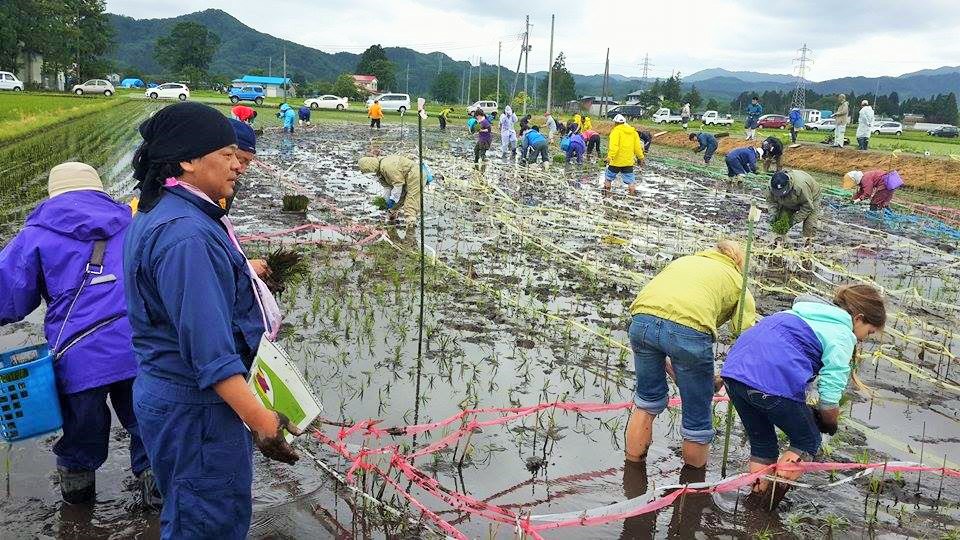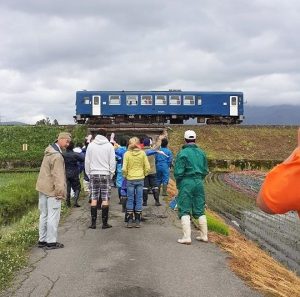Information
AIU Students Change Face of Akita Landscape
“Rice paddy art” (Tanbo aato) originated in Inakadate, a town in Aomori prefecture to Akita’s north, and has since spread across many rice-growing regions, particularly in northern Japan. This year, two AIU students and one professor had the chance to take part in a Rice Paddy Art project in Senboku City, near AIU. The students and local farmers planted different strains of modern and traditional rice varieties, which grow in different colors, to create an image of Tatsuko Hime a legendary beauty from the area whose statue stands over Lake Tazawako in Senboku City.

Local farmers and AIU representatives work together to plant colored strains of rice between the corresponding streamers to create an image of Tatsuko Hime, a woman of legendary beauty whose ill-fated quest to retain eternal youth and life led to her being transformed into a dragon and becoming the master of Lake Tazawako.
(Photo credit: Yen Yi-Han, used with permission)
“We worked directly with the local farmers. They taught us how to plant the seedlings, and where each variety should go to create the picture. It was simple work, but it took time and left us quite sore at the end- but it was a good sore! Afterwards, we had tea and sweets with the farmers. We spoke in Japanese, but there was a translator from the Senboku Tourism Office there to help, too.”

A one-car train passes by the rice paddy during the farmers’ explanation. Once the rice paddy art is visible, students will take a ride to view their finished product.
(Photo Credit: Yen Yi-Han, used with permission)
“It was an amazing experience. At first, we had boots, provided by AIU’s Research and Community Outreach Services (RCOS), but it was hard to walk around in those, so we decided to take them off and walk barefoot through the ankle-deep mud. I’d never been barefoot in the mud before, but it was wonderful to feel the earth through my feet. It was a cold day, so the mud felt nice and warm.
In Akita, there are many opportunities for exchange students to participate in activities like this for free. I hope to join in more in the future!”
“Rice paddy art” (Tanbo aato) originated in Inakadate, a town in Aomori prefecture to Akita’s north, and has since spread across many rice-growing regions, particularly in northern Japan. This year, two AIU students and one professor had the chance to take part in a Rice Paddy Art project in Senboku City, near AIU. The students and local farmers planted different strains of modern and traditional rice varieties, which grow in different colors, to create an image of Tatsuko Hime a legendary beauty from the area whose statue stands over Lake Tazawako in Senboku City.

Local farmers and AIU representatives work together to plant colored strains of rice between the corresponding streamers to create an image of Tatsuko Hime, a woman of legendary beauty whose ill-fated quest to retain eternal youth and life led to her being transformed into a dragon and becoming the master of Lake Tazawako.
(Photo credit: Yen Yi-Han, used with permission)
“We worked directly with the local farmers. They taught us how to plant the seedlings, and where each variety should go to create the picture. It was simple work, but it took time and left us quite sore at the end- but it was a good sore! Afterwards, we had tea and sweets with the farmers. We spoke in Japanese, but there was a translator from the Senboku Tourism Office there to help, too.”

A one-car train passes by the rice paddy during the farmers’ explanation. Once the rice paddy art is visible, students will take a ride to view their finished product.
(Photo Credit: Yen Yi-Han, used with permission)
“It was an amazing experience. At first, we had boots, provided by AIU’s Research and Community Outreach Services (RCOS), but it was hard to walk around in those, so we decided to take them off and walk barefoot through the ankle-deep mud. I’d never been barefoot in the mud before, but it was wonderful to feel the earth through my feet. It was a cold day, so the mud felt nice and warm.
In Akita, there are many opportunities for exchange students to participate in activities like this for free. I hope to join in more in the future!”
